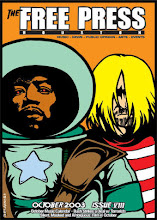The Cove
Humans breathe unconsciously, for instance we breathe in our sleep. Dolphins are mammals that breathe on purpose. With every breath they take they make a conscious decision to inhale air.
The Cove is a provocative hard-hitting documentary about dolphin killing. The film provides momentum from footage that was obtained by stealth. An Ocean’s 11 style team, including a couple of paramilitary ringers and a Hollywood special effects company, are brought together to expose the illegal practices that exist in Taiji, Wakayama, Japan. Because of its remote geography and small population (a few thousand) certain city officials and local fisheries are able to get away with slaughtering dolphins by herding them into a narrow cove with boats, sonic noise and nets. The few dolphins that are captured are sold upwards of $150,000 to theme parks worldwide. While dolphin drive hunting goes on everywhere around the globe the practice is especially egregious in Taiji
Director Louis Psihoyos emphasizes the H. P. Lovecraft nature of the secluded area. Minus the supernatural element of course, the cove and its inhabitants exist apart from general humanity. Psihoyos and Richard O’Barry, a major player in the film, are recognizable by sight to the locals, and thus are hounded, stalked and arrested whenever they show their face. One bizarre character calling himself Private Space follows them with a camcorder, occasionally yelling at them (all in Japanese). But a few townspeople (among them city council members) are on their side, dishonored at the town’s participation in the cover-up.
O’Barry’s story will cement your choice of siding with the good guys. His story of how he became a cetacean activist will sink the listener who fondly remembers the 60s television show Flipper. O’Barry was the dolphin trainer and Cathy was one of five dolphins who played Flipper on the show. O’Barry relates how Cathy, after the show’s over, commits suicide in his arms. “She gave me a look that said she’d given up and just stopped breathing,” he gravely recalls to the camera. Since that time O’Barry gets arrested with frequency for freeing dolphins that are confined in tourist or research enclosures.
Flash forward to the present time and O’Barry’s in his senior years but more than athletic enough to head a covert team to Taiji recruited by himself and Psihoyos that includes seasoned swimmers, night vision photography, and digital cameras hidden in rocks designed by ILM as well as underwater sound equipment.
The effect is overwhelming in its snuff film intensity; the forceful death twitch of a tail, the screeching sounds of mayhem, and the aftermath shot of all the sea water in the cove so blood red it looks like a cranberry and tomato juice cocktail.
The story unfolds in a linear style. At the mid-point when the members of the team arrive and secretly rendezvous for their mission to hide the cameras in the middle of the night the action becomes oddly riveting. While not quite on the top shelf with last year’s caper genre docu Man on Wire, The Cove provides plenty of food for thought not the least of which is the high-in-mercury-level dolphin meat being sold around the world. Dolphins are hardly on an extinction list yet their physical state mirrors our own pollution of their watery atmosphere. Some areas I thought the documentary would go but that are not approached include John C. Lilly’s contribution to dolphin research. Lilly was the model for the George C. Scott role in Day of the Dolphin (1973) and O’Barry must surely have crossed his path at some point. Also the use of dolphins by the Navy or military sonic sound experiments killing sea mammals. Although these are all subjects worthy of their own documentaries. Stick around past the closing credit roll for an extended sequence that shows how The Cove team got one camera past a police blockade because it was hidden inside a giant floating whale balloon.









0 Comments:
Post a Comment
<< Home